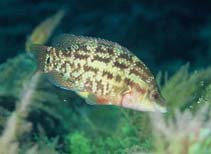Add your observation in Fish WatcherAquaMaps webservice down at the moment
Upload your photos and videos
Pictures | Google imageSymphodus caeruleus
Female picture by Azevedo, J.M.N.
Pictures | Google imageSymphodus caeruleus
Female picture by Azevedo, J.M.N.
Classification / Names Nombres comunes | Sinónimos | Catalog of Fishes(Género, Especie) | ITIS | CoL | WoRMS | Cloffa
> Eupercaria/misc (Various families in series Eupercaria) > Labridae (Wrasses)
Etymology: Symphodus: Greek, syn, symphysis = grown together + Greek, odous = teeth (Ref. 45335); caeruleus: Named for th edistinctive blue coloration of males.
Etymology: Symphodus: Greek, syn, symphysis = grown together + Greek, odous = teeth (Ref. 45335); caeruleus: Named for th edistinctive blue coloration of males.
Environment: milieu / climate zone / depth range / distribution range Ecología
marino demersal; no migratorio; rango de profundidad 1 - 30 m (Ref. 35939), usually 5 - 15 m (Ref. 35939). Tropical; 39°N - 36°N, 32°W - 24°W
Distribución Países | Áreas FAO | Ecosistemas | Ocurrencias, apariciones | Point map | Introducciones | Faunafri
Northeast Atlantic: Madeira, Canary Islands and the Azores Islands.
Tamaño / Peso / Age
Maturity: Lm ? range ? - ? cm
Max length : 21.5 cm SL macho / no sexado; (Ref. 35939); 17.5 cm SL (female)
Max length : 21.5 cm SL macho / no sexado; (Ref. 35939); 17.5 cm SL (female)
Short description Claves de identificación | Morfología | Morfometría
Espinas dorsales (total) : 17 - 18; Radios blandos dorsales (total) : 8 - 9; Espinas anales: 5 - 6; Radios blandos anales: 7 - 9. Modal count of rays on dorsal fin 26 and anal fin 14; scales on lateral line 33-34; dark blue coloration of the males during spawning season (Ref. 35939).
Oviparous, distinct pairing during breeding (Ref. 205). Males build dish shaped nests and guard the eggs (Ref. 205).
Life cycle and mating behavior Madurez | Reproducción | Puesta | Huevos | Fecundidad | Larva
Oviparous, distinct pairing during breeding (Ref. 205). Males build dish shaped nests and guard the eggs (Ref. 205).
Main reference
Upload your references | Referencias | Coordinador : Westneat, Mark | Colaboradores
Azevedo, M., 1999. Centrolabrus caeruleus sp.nov., a long unrecognized species of marine fish (Teleostei, Labridae) from the Azores. Bocagiana 196:1-11. (Ref. 35939)
IUCN Red List Status (Ref. 130435: Version 2024-2)
Least Concern (LC) ; Date assessed: 15 March 2015
CITES
Not Evaluated
Threat to humans
Harmless
Human uses
FAO - Publication: search | FishSource |
Más información
Trophic ecology
componentes alimenticios
Composición de la dieta
consumo de alimento
Food rations
Despredadores
componentes alimenticios
Composición de la dieta
consumo de alimento
Food rations
Despredadores
Ecology
Ecología
Ecología
Population dynamics
Coeficiente del crecimiento para
Max. ages / sizes
Length-weight rel.
Length-length rel.
Length-frequencies
Mass conversion
Reclutamiento
Abundancia
Coeficiente del crecimiento para
Max. ages / sizes
Length-weight rel.
Length-length rel.
Length-frequencies
Mass conversion
Reclutamiento
Abundancia
Life cycle
Reproducción
Madurez
Maturity/Gills rel.
Fecundidad
Puesta
Spawning aggregations
Huevos
Egg development
Larva
Dinámica larvaria
Reproducción
Madurez
Maturity/Gills rel.
Fecundidad
Puesta
Spawning aggregations
Huevos
Egg development
Larva
Dinámica larvaria
Anatomy
Superficie branquial
Brain
Otolith
Superficie branquial
Brain
Otolith
Physiology
Body composition
Nutrients
Consumo del oxígeno
Tipo de natación
Velocidad de natación
Visual pigments
Fish sound
Diseases & Parasites
Toxicity (LC50s)
Body composition
Nutrients
Consumo del oxígeno
Tipo de natación
Velocidad de natación
Visual pigments
Fish sound
Diseases & Parasites
Toxicity (LC50s)
Genetics
Genética
Heterozygosity
heritabilidad
Genética
Heterozygosity
heritabilidad
Human related
Aquaculture systems
Perfiles de acuicultura
Razas
Ciguatera cases
Stamps, coins, misc.
Aquaculture systems
Perfiles de acuicultura
Razas
Ciguatera cases
Stamps, coins, misc.
Herramientas
E-book | Guía de campo | Asistente para frecuencias de tallas | Herramienta de ciclo de vida | Mapa de puntos | Classification Tree
| Catch-MSY |
Special reports
Download XML
Fuentes de Internet
AFORO (otoliths) | Aquatic Commons | BHL | Cloffa | BOLDSystems | Websites from users | Check FishWatcher | CISTI | Catalog of Fishes: Género, Especie | DiscoverLife | ECOTOX | FAO - Publication: search | Faunafri | Fishipedia | Fishtrace | GenBank: genome, nucleotide | GloBI | Google Books | Google Scholar | Google | IGFA World Record | MitoFish | Bases de datos nacionales | Otolith Atlas of Taiwan Fishes | PubMed | Reef Life Survey | Socotra Atlas | Árbol de la vida | Wikipedia: Go, búsqueda | World Records Freshwater Fishing | Expediente Zoológico
Estimates based on models
Preferred temperature (Ref. 123201): 18.7 - 19.1, mean 18.8 °C (based on 9 cells).
Phylogenetic diversity index (Ref. 82804): PD50 = 0.5005 [Uniqueness, from 0.5 = low to 2.0 = high].
Bayesian length-weight: a=0.01000 (0.00471 - 0.02125), b=3.07 (2.90 - 3.24), in cm total length, based on LWR estimates for this Genus-body shape (Ref. 93245).
Nivel trófico (Ref. 69278): 3.5 ±0.5 se; based on size and trophs of closest relatives
Resiliencia (Ref. 120179): Medio, población duplicada en un tiempo mínimo de 1.4-4.4 años (Preliminary K or Fecundity.).
Fishing Vulnerability (Ref. 59153): Low vulnerability (16 of 100).




